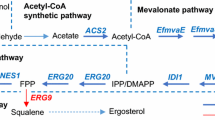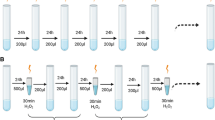Abstract
Conflict between cell growth and product accumulation is frequently encountered in the biosynthesis of secondary metabolites. To address the growth-production conflict in yeast strains harboring the isoprene synthetic pathway in the mitochondria, the dynamic control of isoprene biosynthesis was explored. A dual temperature regulation system was developed through engineering and expression regulation of the transcriptional activator Gal4p. A cold-sensitive mutant, Gal4ep19, was created by directed evolution of Gal4p based on an internally developed growth-based high-throughput screening method and expressed under the heat-shock promoter PSSA4 to control the expression of PGAL-driven pathway genes in the mitochondria. Compared to the control strain with constitutively expressed wild-type Gal4p, the dual temperature regulation strategy led to 34.5% and 72% improvements in cell growth and isoprene production, respectively. This study reports the creation of the first cold-sensitive variants of Gal4p by directed evolution and provides a dual temperature control system for yeast engineering that may also be conducive to the biosynthesis of other high-value natural products.

Similar content being viewed by others
References
Vickers C E, Suriana S. Isoprene. Advances in Biochemical Engineering/Biotechnology, 2015, 148(9): 289–317
Lv X M, Wang F, Zhou P P, Ye L D, Xie W P, Xu H M, Yu H W. Dual regulation of cytoplasmic and mitochondrial acetyl-CoA utilization for improved isoprene production in Saccharomyces cerevisiae. Nature Communications, 2016, 7(1): 12851
Yao Z, Zhou P P, Su B M, Su S S, Ye L D, Yu H W. Enhanced isoprene production by reconstruction of metabolic balance between strengthened precursor supply and improved isoprene synthase in Saccharomyces cerevisiae. ACS Synthetic Biology, 2018, 7(9): 2308–2316
Wang F, Lv X M, Xie W P, Zhou P P, Zhu Y Q, Yao Z, Yang C C, Yang X H, Ye L D, Yu H W. Combining Gal4p-mediated expression enhancement and directed evolution of isoprene synthase to improve isoprene production in Saccharomyces cerevisiae. Metabolic Engineering, 2017, 39: 257–266
Cao X, Yang S, Cao C, Zhou Y J. Harnessing sub-organelle metabolism for biosynthesis of isoprenoids in yeast. Synthetic and Systems Biotechnology, 2020, 5(3): 179–186
Traven A, Jelicic B, Sopta M. Yeast Gal4: a transcriptional paradigm revisited. EMBO Reports, 2006, 7(5): 496–499
Da Silva N A, Srikrishnan S. Introduction and expression of genes for metabolic engineering applications in Saccharomyces cerevisiae. FEMS Yeast Research, 2012, 12(2): 197–214
Xie W P, Liu M, Lv X M, Lu W Q, Gu J L, Yu H W. Construction of a controllable β-carotene biosynthetic pathway by decentralized assembly strategy in Saccharomyces cerevisiae. Biotechnology and Bioengineering, 2014, 111(1): 125–133
Tan G H, Chen M, Foote C, Tan C. Temperature-sensitive mutations made easy: generating conditional mutations by using temperature-sensitive inteins that function within different temperature ranges. Genetics, 2009, 183(1): 13–22
Zeidler M P, Tan C, Bellaiche Y, Cherry S, Häder S, Gayko U, Perrimon N. Temperature-sensitive control of protein activity by conditionally splicing inteins. Nature Biotechnology, 2004, 22(7): 871–876
Chakshusmathi G, Mondal K, Lakshmi G S, Singh G, Roy A, Babu Ch R, Madhusudhanan S, Varadarajan R. Design of temperature-sensitive mutants solely from amino acid sequence. Proceedings of the National Academy of Sciences of the United States of America, 2004, 101(21): 7925–7930
Mondal K, Dastidar A G, Singh G, Madhusudhanan S, Gande S L, VijayRaghavan K, Varadarajan R. Design and isolation of temperature-sensitive mutants of Gal4 in yeast and Drosophila. Journal of Molecular Biology, 2007, 370(5): 939–950
Zhou P P, Xie W P, Yao Z, Zhu Y Q, Ye L D, Yu H W. Development of a temperature-responsive yeast cell factory using engineered Gal4 as a protein switch. Biotechnology and Bioengineering, 2018, 115(5): 1321–1330
Mondal K, VijayRaghavan K, Varadarajan R. Design and utility of temperature-sensitive Gal4 mutants for conditional gene expression in Drosophila. Fly, 2007, 1(5): 282–286
Boeke J D, LaCroute F, Fink G R. A positive selection for mutants lacking orotidine-5′-phosphate decarboxylase activity in yeast 5-fluoro-orotic acid resistance. Molecular Genetics and Genomics, 1984, 197(2): 345–346
Sikorski R, Boeke J D. In vitro mutagenesis and plasmid shuffling: from cloned gene to mutant yeast. Methods in Enzymology, 1991, 194: 302–318
Meng X D, Smith R M, Giesecke A V, Joung J K, Wolfe S A. Counter-selectable marker for bacterial-based interaction trap systems. BioTechniques, 2006, 40(2): 179–184
Baliga C, Majhi S, Mondal K, Bhattacharjee A, VijayRaghavan K, Varadarajan R. Rational elicitation of cold-sensitive phenotypes. Proceedings of the National Academy of Sciences of the United States of America, 2016, 113(18): E2506–E2515
Brachmann C B, Davies A, Cost G J, Caputo E, Li J, Hieter P, Boeke J D. Designer deletion strains derived from Saccharomyces cerevisiae S288C: a useful set of strains and plasmids for PCR-mediated gene disruption and other applications. Yeast (Chichester, England), 1998, 14(2): 115–132
Gietz R D, Schiestl R H. High-efficiency yeast transformation using the LiAc/SS carrier DNA/PEG method. Nature Protocols, 2007, 2(1): 31–34
Livak K J, Schmittgen T D. Analysis of relative gene expression data using real-time quantitative PCR and the 2−ΔΔCT Method. Methods (San Diego, Calif.), 2001, 25(4): 402–408
van Hoek P, de Hulster E, van Dijken J P, Pronk J T. Fermentative capacity in high-cell-density fed-batch cultures of baker’s yeast. Biotechnology and Bioengineering, 2000, 68(5): 517–523
Meng X, Smith R M, Giesecke A V, Keith Joung J, Wolfe S A. Counter-selectable marker for bacterial-based interaction trap systems. BioTechniques, 2006, 40(2): 179–184
Hong M Q, Fitzgerald M X, Harper S, Luo C, Speicher D W, Marmorstein R. Structural basis for dimerization in DNA recognition by Gal4. Structure (London, England), 2008, 16(7): 1019–1026
Schjerling P, Holmberg S. Comparative amino acid sequence analysis of the C6 zinc cluster family of transcriptional regulators. Nucleic Acids Research, 1996, 24(23): 4599–4607
Ma J, Ptashne M. Deletion analysis of GAL4 defines two transcriptional activating segments. Cell, 1987, 48(5): 847–853
Johnston M, Dover J. Mutational analysis of the Gal4-encoded transcriptional activator protein of Saccharomyces cerevisiae. Genetics, 1988, 120(1): 63–74
Zhou P P, Xu N N, Yang Z F, Du Y, Yue C L, Xu N, Ye L D. Directed evolution of the transcription factor Gal4 for development of an improved transcriptional regulation system in Saccharomyces cerevisiae. Enzyme and Microbial Technology, 2020, 142: 109675
Boorstein W R, Craig E A. Structure and regulation of the SSA4 HSP70 gene of Saccharomyces cerevisiae. Journal of Biological Chemistry, 1990, 265(31): 18912–18921
Chen Y, Daviet L, Schalk M, Siewers V, Nielsen J. Establishing a platform cell factory through engineering of yeast acetyl-CoA metabolism. Metabolic Engineering, 2013, 15: 48–54
Gill G, Ptashne M. Negative effect of the transcriptional activator GAL4. Nature, 1988, 334(6184): 721–724
Acknowledgements
This work was financially supported by the National Key Research and Development Program of China (Grant Nos. 2018YFA0901800 and 2020YFA0908400), the National Natural Science Foundation of China (Grant No. 21776244), and Zhejiang Provincial Natural Science Foundation of China (Grant No. LZ20B060002).
Author information
Authors and Affiliations
Corresponding authors
Electronic Supplementary Material
Rights and permissions
About this article
Cite this article
Lin, J., Yao, Z., Lyu, X. et al. Development of a dual temperature control system for isoprene biosynthesis in Saccharomyces cerevisiae. Front. Chem. Sci. Eng. 16, 1079–1089 (2022). https://doi.org/10.1007/s11705-021-2088-0
Received:
Accepted:
Published:
Issue Date:
DOI: https://doi.org/10.1007/s11705-021-2088-0




